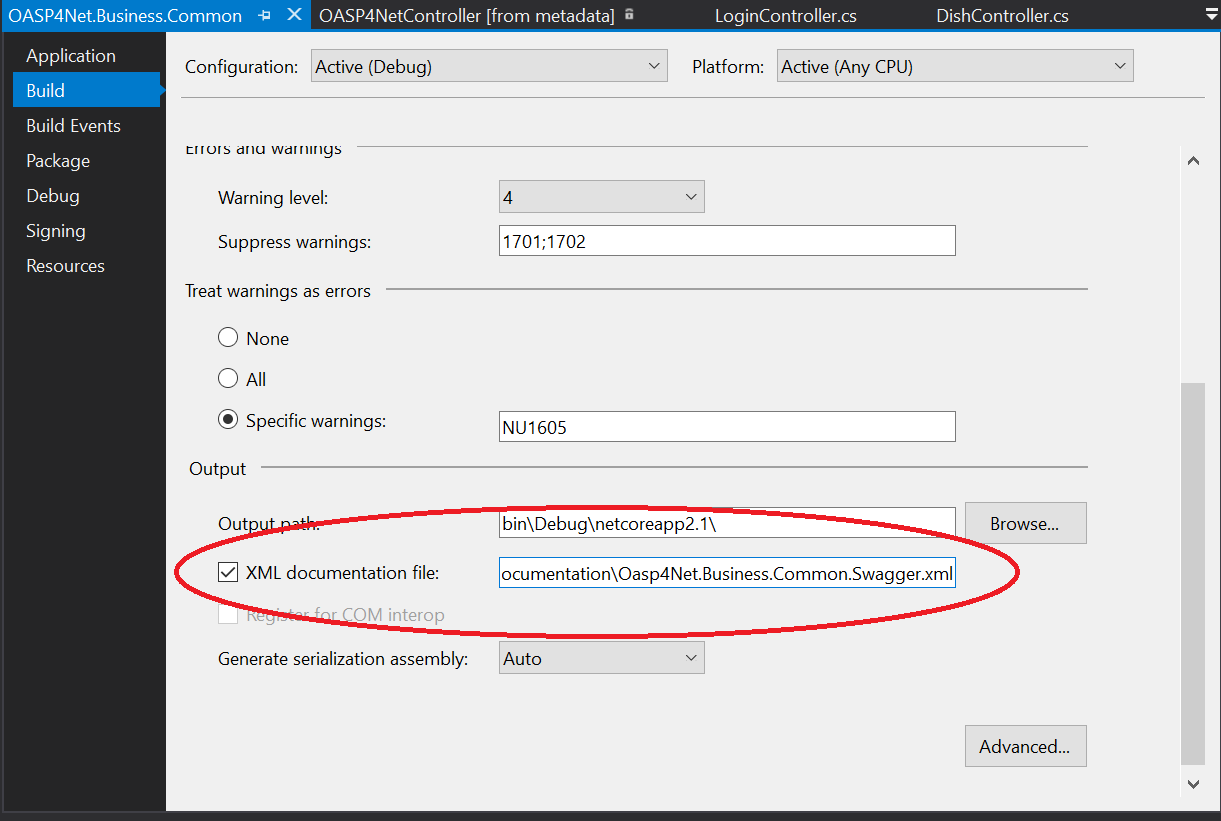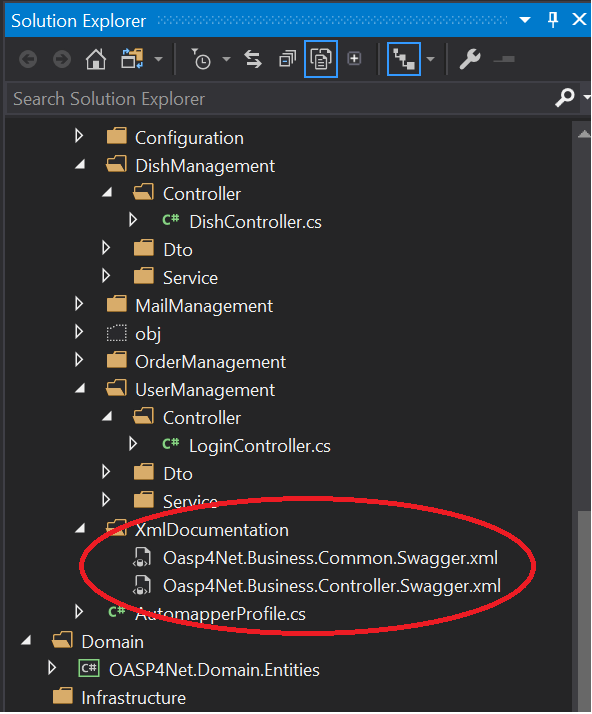| OASP4Net is composed by a number of packages that increases the functionality and boosts time development. Each package has it’s own configuration to make them work properly. In appsettings.json set up your environment. On appsettings.{environment}.json you can configure each component. |
You can get the OASP packages on nuget.org.
OASP4Net.Domain.Context contains the extended class OASP4NetBaseContext in order to make easier the process of having a model context configured against different database engines. This configuration allows an easier testing configuration against local and in memory databases.
-
Install package on your solution:
PM> Install-Package OASP4Net.Domain.Context
-
Add to appsettings.{environment}.json file your database connections:
"ConnectionStrings":
{
"DefaultConnection":
"Server=localhost;Database=MyThaiStar;User Id=sa;Password=sa;MultipleActiveResultSets=True;",
"AuthConnection":
"Server=(localdb)\\mssqllocaldb;Database=aspnet-DualAuthCore-5E206A0B-D4DA-4E71-92D3-87FD6B120C5E;Trusted_Connection=True;MultipleActiveResultSets=true",
"SqliteConnection": "Data Source=c:\\tmp\\membership.db;"
}-
On Startup.cs :
void ConfigureServices(IServiceCollection services)-
Add your database connections defined on previous point:
services.ConfigureDataBase(
new Dictionary<string, string> {
{ConfigurationConst.DefaultConnection, Configuration.GetConnectionString(ConfigurationConst.DefaultConnection) }});-
On OASP4Net.Application.Configuration.Startup/DataBaseConfiguration/ConfigureDataBase configure your connections.
Unit of work implementation for OASP solution. This unit of work provides the different methods to access the data layer with an atomic context. Sync and Async repository operations are provided. Customized Eager Loading method also provided for custom entity properties.
-
Install package on your solution:
PM> Install-Package OASP4Net.Domain.UnitOfWork
-
Add this line of code:
services.AddUnitOfWorkDependencyInjection();On
Startup.cs/ConfigureServices(IServiceCollection services)
or on:
OASP4Net.Application.Configuration.Startup/DependencyInjectionConfiguration/ConfigureDependencyInjectionService method.
OASP4NET Application user classes to implement basic Microsoft’s basic authentication in order to be used on authentication methodologies such Jason Web Token (JWT).
-
Install package on your solution:
PM> OASP4Net.Infrastructure.ApplicationUser
-
Add the database connection string for user management on appsettings.{environment}.json:
"ConnectionStrings":
{
"AuthConnection":
"Server=(localdb)\\mssqllocaldb;Database=aspnet-DualAuthCore-5E206A0B-D4DA-4E71-92D3-87FD6B120C5E;Trusted_Connection=True;MultipleActiveResultSets=true"
}-
Add the following line of code
services.AddApplicationUserDependencyInjection();On
Startup.cs/ConfigureServices(IServiceCollection services)
or on:
OASP4Net.Application.Configuration.Startup/DependencyInjectionConfiguration/ConfigureDependencyInjectionService method.
-
Add the data seeder on Configure method on start.cs class:
public void Configure(IApplicationBuilder app, IHostingEnvironment env, DataSeeder seeder)
{
...
app.UseAuthentication();
seeder.SeedAsync().Wait();
...
}-
You can use the following methods to set up the database configuration:
public static void AddApplicationUserDbContextInMemoryService(this IServiceCollection services) public static void AddApplicationUserDbContextSQliteService(this IServiceCollection services, string connectionString) public static void AddApplicationUserDbContextSQlServerService(this IServiceCollection services, string connectionString)
-
The method AddApplicationUserDbContextInMemoryService uses the AuthContext connection string name to set up the database.
-
This component is used with the components OASP4Net.Infrastructure.JWT and OASP4Net.Infrastructure.JWT.MVC.
Basic client classes to invoke GET/POST methods asynchronously. This component has the minimal clases to send basic data. For more complex operations please use ASP4Net.Infrastructure.Extensions.
-
Install package on your solution:
PM> OASP4Net.Infrastructure.Communication
-
Create an instance of RestManagementService class.
-
Use next methods to use GET/POST basic options:
public Task<string> CallGetMethod(string url);
public Task<Stream> CallGetMethodAsStream(string url);
public Task<string> CallPostMethod<T>(string url, T dataToSend);
public Task<string> CallPutMethod<T>(string url, T dataToSend);Enables CORS configuration for OASP4Net application. Multiple domains can be configured from configuration. Mandatory to web clients (p.e. Angular) to prevent making AJAX requests to another domain.
Cross-Origin Resource Sharing (CORS) is a mechanism that uses additional HTTP headers to tell a browser to let a web application running at one origin (domain) have permission to access selected resources from a server at a different origin. A web application makes a cross-origin HTTP request when it requests a resource that has a different origin (domain, protocol, and port) than its own origin.
Plase reffer to this link to get more information about CORS and .Net core.
-
Install package on your solution:
PM> OASP4Net.Infrastructure.Cors
-
You can configure your Cors configuration on appsettings.{environment}.json:
CorsPolicy: indicates the name of the policy. You can use this name to add security headers on your API exposed methods.
Origins: The alowed domains
Headers: The allowed headers such accept,content-type,origin,x-custom-header
-
If you specify the cors configuration as empty array, a default Corspolicy will be enabled enabled with all origins enabled:
"Cors": []-
On the other hand, you can specify different Cors policies in your solution as follows:
"Cors": []
[
{
"CorsPolicy": "CorsPolicy1",
"Origins": "http:example.com,http:www.contoso.com",
"Headers": "accept,content-type,origin,x-custom-header",
"Methods": "GET,POST,HEAD",
"AllowCredentials": true
},
{
"CorsPolicy": "CorsPolicy2",
"Origins": "http:example.com,http:www.contoso.com",
"Headers": "accept,content-type,origin,x-custom-header",
"Methods": "GET,POST,HEAD",
"AllowCredentials": true
}
]Miscellaneous extension libreray which contains : - Predicate expression builder - DateTime formatter - HttpClient - HttpContext (Middleware support)
Predicate expression builder
-
Use this expression builder to generate lambda expressions dynamically.
var predicate = PredicateBuilder.True<T>();
Where T is a class. At this moment, you can build your expression and apply it to obtain your results in a efficient way and not retrieving data each time you apply an expression.
-
Exaple from My Thai Star .Net Core implementation:
public async Task<PaginationResult<Dish>> GetpagedDishListFromFilter(int currentpage, int pageSize, bool isFav, decimal maxPrice, int minLikes, string searchBy, IList<long> categoryIdList, long userId)
{
var includeList = new List<string>{"DishCategory","DishCategory.IdCategoryNavigation", "DishIngredient","DishIngredient.IdIngredientNavigation","IdImageNavigation"};
//Here we create our predicate builder
var dishPredicate = PredicateBuilder.True<Dish>();
//Now we start applying the different criterias:
if (!string.IsNullOrEmpty(searchBy))
{
var criteria = searchBy.ToLower();
dishPredicate = dishPredicate.And(d => d.Name.ToLower().Contains(criteria) || d.Description.ToLower().Contains(criteria));
}
if (maxPrice > 0) dishPredicate = dishPredicate.And(d=>d.Price<=maxPrice);
if (categoryIdList.Any())
{
dishPredicate = dishPredicate.And(r => r.DishCategory.Any(a => categoryIdList.Contains(a.IdCategory)));
}
if (isFav && userId >= 0)
{
var favourites = await UoW.Repository<UserFavourite>().GetAllAsync(w=>w.IdUser == userId);
var dishes = favourites.Select(s => s.IdDish);
dishPredicate = dishPredicate.And(r=> dishes.Contains(r.Id));
}
// Now we can use the predicate to retrieve data from database with just one call
return await UoW.Repository<Dish>().GetAllIncludePagedAsync(currentpage, pageSize, includeList, dishPredicate);
}HttpContext
-
TryAddHeader method is used on OASP4Net.Infrastructure.Middleware component to add automatically response header options such authorization.
Cryptography
-
Adds to string class the following conversion methods:
ToSHA256 ToSHA512 ToMD5
Datetime
-
Adds the ConvertDateTimeToMilliseconds method to DateTime class. It is very helpfull to get aligned with frontend frameworks.
Http Client
-
Contains synchronous and asyncrhonous methods to perform Http method calls such:
Post Put Patch
JSON Web Token (JWT) is an open standard (RFC 7519) that defines a compact and self-contained way for securely transmitting information between parties as a JSON object. This information can be verified and trusted because it is digitally signed. JWTs can be signed using a secret (with the HMAC algorithm) or a public/private key pair using RSA or ECDSA.
https://jwt.io/introduction/
-
OASP component to manage JWT standard to provide security to .Net API applications.
-
Install package on your solution:
PM> OASP4Net.Infrastructure.JWT
-
You can configure your JWT configuration on appsettings.{environment}.json:
"JWT": {
"Audience": "MyThaiStar",
"Issuer": "MyThaiStar",
"TokenExpirationTime": 60,
"ValidateIssuerSigningKey": true,
"ValidateLifetime": true,
"ClockSkew": 5,
"Certificate": "oasp4net.pfx",
"CertificatePassword": "oasp4net"
}-
ClockSkew indicates the token expiration time in minutes
-
Certificate you can especify the name of your certificate (if it is on the same path) or the full path of the certificate. If the certificate does not exists an exception will be raised.
-
Add this line of code:
services.AddBusinessCommonJwtPolicy();On
Startup.cs/ConfigureServices(IServiceCollection services)
or on:
OASP4Net.Application.Configuration.Startup/JwtApplicationConfiguration/ConfigureJwtPolicy method.
-
Inside the AddBusinessCommonJwtPolicy method you can add your JWT Policy like in My Thai Star application sample:
services.ConfigureJwtAddPolicy("MTSWaiterPolicy", "role", "waiter");-
Extend your _ Microsoft.AspNetCore.Mvc.Controller_ class with OASP4NetJWTController class:
public class LoginController : OASP4NetJWTController
{
private readonly ILoginService _loginService;
public LoginController(ILoginService loginService, SignInManager<ApplicationUser> signInManager, UserManager<ApplicationUser> userManager, ILogger<LoginController> logger, IMapper mapper) : base(logger,mapper)
{
_loginService = loginService;
}
....-
In order to generate a JWT, you should implement the JWT generation on user login. For example, in My Thai Star is created as follows:
public async Task<IActionResult> Login([FromBody]LoginDto loginDto)
{
try
{
if (loginDto == null) return Ok();
var loged = await _loginService.LoginAsync(loginDto.UserName, loginDto.Password);
if (loged)
{
var user = await _loginService.GetUserByUserNameAsync(loginDto.UserName);
var encodedJwt = new JwtClientToken().CreateClientToken(_loginService.GetUserClaimsAsync(user));
Response.Headers.Add("Access-Control-Expose-Headers", "Authorization");
Response.Headers.Add("Authorization", $"{JwtBearerDefaults.AuthenticationScheme} {encodedJwt}");
return Ok(encodedJwt);
}
else
{
Response.Headers.Clear();
return StatusCode((int)HttpStatusCode.Unauthorized, "Login Error");
}
}
catch (Exception ex)
{
return StatusCode((int)HttpStatusCode.InternalServerError, $"{ex.Message} : {ex.InnerException}");
}
}-
In My Thai Star the JWT will contain the user information such id, roles…
-
Once you extend your controller with OASP4NetJWTController you will have available these methods to simplify user management:
public interface IOASP4NetJWTController
{
// Gets the current user
JwtSecurityToken GetCurrentUser();
// Gets an specific asigned claim of current user
Claim GetUserClaim(string claimName, JwtSecurityToken jwtUser = null);
// Gets all the asigned claims of current user
IEnumerable<Claim> GetUserClaims(JwtSecurityToken jwtUser = null);
}-
OASP4Net support for middleware classes.
-
In ASP.NET Core, middleware classes can handle an HTTP request or response. Middleware can either:
-
Handle an incoming HTTP request by generating an HTTP response.
-
Process an incoming HTTP request, modify it, and pass it on to another piece of middleware.
-
Process an outgoing HTTP response, modify it, and pass it on to either another piece of middleware, or the ASP.NET Core web server.
-
-
OASP4Net supports the following automatic response headers:
-
AccessControlExposeHeader
-
StrictTransportSecurityHeader
-
XFrameOptionsHeader
-
XssProtectionHeader
-
XContentTypeOptionsHeader
-
ContentSecurityPolicyHeader
-
PermittedCrossDomainPoliciesHeader
-
ReferrerPolicyHeader:toc: macro
-
-
Install package on your solution:
PM> OASP4Net.Infrastructure.Middleware
-
You can configure your Middleware configuration on appsettings.{environment}.json:
"Middleware": {
"Headers": {
"AccessControlExposeHeader": "Authorization",
"StrictTransportSecurityHeader": "",
"XFrameOptionsHeader": "DENY",
"XssProtectionHeader": "1;mode=block",
"XContentTypeOptionsHeader": "nosniff",
"ContentSecurityPolicyHeader": "",
"PermittedCrossDomainPoliciesHeader": "",
"ReferrerPolicyHeader": ""
}
}-
On the above sample, the server aplication will add to response header the AccessControlExposeHeader, XFrameOptionsHeader, XssProtectionHeader and XContentTypeOptionsHeader headers.
-
If the header response type does not have a value, it will not be added to the response headers.
Common classes to extend controller functionality on API. Also provides support for paged results in OASP applications and autommaper injected class.
-
The generic class ResultObjectDto<T> provides a typed result object with pagination.
-
The extended class provides the following methods:
ResultObjectDto<T> GenerateResultDto<T>(int? page, int? size, int? total);
ResultObjectDto<T> GenerateResultDto<T>(List<T> result, int? page = null, int? size = null);-
GenerateResultDto provides typed ResultObjectDto object or a list of typed ResultObjectDto object. The aim of this methods is to provide a clean management for result objects and not repeating code through the different controller classes.
-
The following sample from My Thai Star shows how to use it:
public async Task<IActionResult> Search([FromBody] FilterDtoSearchObject filterDto)
{
if (filterDto == null) filterDto = new FilterDtoSearchObject();
try
{
var dishList = await _dishService.GetDishListFromFilter(false, filterDto.GetMaxPrice(), filterDto.GetMinLikes(), filterDto.GetSearchBy(),filterDto.GetCategories(), -1);
return new OkObjectResult(GenerateResultDto(dishList).ToJson());
}
catch (Exception ex)
{
return StatusCode((int)HttpStatusCode.InternalServerError, $"{ex.Message} : {ex.InnerException}");
}
}-
OASP Swagger abstraction to provide full externalized easy configuration.
-
Swagger offers the easiest to use tools to take full advantage of all the capabilities of the OpenAPI Specification (OAS).
-
Install package on your solution:
PM> OASP4Net.Infrastructure.Swagger
-
You can configure your Swagger configuration on appsettings.{environment}.json:
"Swagger": {
"Version": "v1",
"Title": "OASP4Net API",
"Description": "A simple ASP.NET Core Web API capable project",
"Terms": "OASP",
"Contact": {
"Name": "OASP4Net",
"Email": "",
"Url": ""
},
"License": {
"Name": "OASP4Net",
"Url": ""
},
"Endpoint": {
"Name": "V1 Docs",
"Url": "/swagger/v1/swagger.json"
}
}-
Add this line of code:
services.ConfigureSwaggerService();On
Startup.cs/ConfigureServices(IServiceCollection services)
-
Also add this line of code:
app.ConfigureSwaggerApplication();On
Startup.cs/Configure(IApplicationBuilder app, IHostingEnvironment env)
-
Ensure your API actions and non-route parameters are decorated with explicit "Http" and "From" bindings.
-
To access to swagger UI launch your API project and type in your html browser the url http://localhost:yourPort/swagger.
-
In order to generate the documentation annotate your actions with summary, remarks and response tags:
/// <summary>
/// Method to make a reservation with potentiel guests. The method returns the reservation token with the format: {(CB_|GB_)}{now.Year}{now.Month:00}{now.Day:00}{_}{MD5({Host/Guest-email}{now.Year}{now.Month:00}{now.Day:00}{now.Hour:00}{now.Minute:00}{now.Second:00})}
/// </summary>
/// <param name="bookingDto"></param>
/// <response code="201">Ok.</response>
/// <response code="400">Bad request. Parser data error.</response>
/// <response code="401">Unathorized. Autentication fail</response>
/// <response code="403">Forbidden. Authorization error.</response>
/// <response code="500">Internal Server Error. The search process ended with error.</response>
[HttpPost]
[HttpOptions]
[Route("/mythaistar/services/rest/bookingmanagement/v1/booking")]
[AllowAnonymous]
[EnableCors("CorsPolicy")]
public async Task<IActionResult> BookingBooking([FromBody]BookingDto bookingDto)
{
try
{
...
-
Ensure that your project has the generate XML documentation file check active on buid menu:
-
Ensure that your XML files has the attribute copy always to true:
-
At this point you can find this classes:
-
BaseManagementTest
-
DatabaseManagementTest<T> (Where T is a OASP4NetBaseContext class)
-
-
For unit testing, inherit a class from BaseManagementTest.
-
For integration tests, inherit a class from DatabaseManagementTest.
-
The recomended databases in integration test are in memory database or SQlite database.
-
Please check My thai Star test project.


